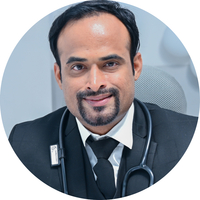All the cells present in our bodies are expected to possess 46 chromosomes for their normal functioning. However, individuals with Down’s syndrome have 47 chromosomes, the extra one being chromosome 21.
Chromosomes are supercoiled DNA strands which work in pairs to perform optimally. The only cause of Down’s syndrome is this extra copy of chromosome 21 or sometimes an extra piece of it. This means that each body cell has three copies of chromosome 21, instead of two, present conventionally. This is why it is also called trisomy 21. This extra copy or piece is responsible for all the physical, intellectual and other health-related issues that the sufferer has to face.
But, it is important to note that the occurrence of trisomy is indispensably a genetic event and neither the parent nor the affected has any control over the condition. It occurs at the time of conception itself and cannot be reversed.
The chromosomal abnormality responsible for the development of this syndrome occurs as an utterly random event during the formation of gametes or reproductive cells in either of the parent. Usually, this abnormality develops in the egg cells but sometimes it can even occur in the sperm. This is when an extra chromosome 21 is formed. If these abnormal cells continue to take part in the process of fertilisation, the extra chromosome will be expressed in the zygote and will thereafter be a component of the foetal cells.
When following this mechanism, Down’s syndrome is not inheritable. This means that Down’s syndrome resulting from trisomy 21 is not caused because of an abnormality in the parents and is not passed down from them in any form.
But, there is a form of this disorder which is possibly inheritable. This is believed to be caused by the process of translocation, and it is then called translocation Down’s syndrome. Translocation occurs when a part of chromosome 21 attaches itself to another chromosome during the process of genetic formation. This could either occur in either of the parental reproductive cells, the sperm or the ova, or at the time of fertilisation. It may even occur during early stages of foetal development. This is what refers to the extra piece of chromosome 21 mentioned above. So, foetuses acquiring this extra material from chromosome 21 will have two of chromosome 21 and genetic material from this extra piece, getting it down to the same scenario of having 3 of these chromosomes.
The parent of the affected already carries this disrupted form of genetic material between chromosome 21 and the other chromosome. But, since this disruption is balanced, the parent does not exhibit any symptoms. When passed on to the offspring, an imbalance in this genetic material is likely to occur, causing this extra material from chromosome 21 to lead to the expected symptoms of Down’s syndrome.
The extra chromosome in Down's syndrome is ascertained to be present in every single cell of the body, of all the million we contain. However, sometimes, it is only represented in some or few of these cells and is then called mosaic Down’s syndrome. This implies that some of the body cells have a normal genetic composition, while others possess 47 chromosomes. Even this type cannot be inherited by the offsprings.
Heredity is not a quite common cause of Down’s syndrome with only 1% of the total cases being reported owing to inheritance. Only the types resulting from translocation of the chromosome are inheritable, which occurs in one-third of the total occurrences.
Parent giving birth to a baby affected with Down’s syndrome have a 1 in 100 chance of its occurrence in the second baby. This risk is about 10-15% from a maternal carrier and only 3% when the father is a carrier of the gene.

 Doctors for Down Syndrome
Doctors for Down Syndrome 


































